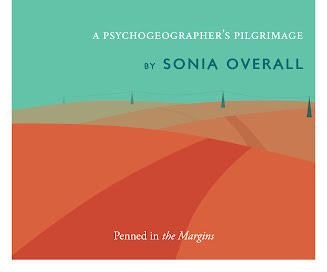Themes: Pyscogeography, Pilgrimage, Walking, Kent, Cambridgeshire, Norfolk
Read this if: You really really like walking
Don’t read this if: You’re not intensely interested in descriptions of English countryside.
Links to purchase: Penned in the Margins, Amazon
When I saw the cover for Heavy Time, I was intrigued by not only the beautiful blue and orange cover art, but also the accompanying tagline: ‘A pyschogeographer’s pilgrimage’. The term psychogeography didn’t mean anything to me, but it certainly sounded interesting. A little research led me to the Tate Collection’s definition: “Psychogeography describes the effect of a geographical location on the emotions and behaviour [psyche] of individuals”. Straight forward enough. Heavy Time is basically a travelogue, but with an extra emphasis on the emotions of the traveler as opposed to the things they see along the way.
The journey undertaken by the author is an idiosyncratic one. It is composed of three legs. The first is a historic pilgrimage route in reverse, whereas Chaucer’s pilgrims walked from Southwark (London) to Canterbury, the author walks from her home in Canterbury, up to London. The second leg takes the author north from London to her hometown of Ely in Cambridgeshire. The final leg is another historic pilgrim’s route: Ely to Walsingham Abbey. The journey runs through the full spectrum of English habitat: bucolic countryside, unremarkable suburbs, and bustling cities. But again, this isn’t about the places visited, but the mental states inspired by the places. Unfortunately, the author develops blisters early on in the journey, which deteriorate as she walks 10+ miles per day. Subsequently, the inspiration of the places she visits is often muffled by the blanket of pain that envelopes the author. There are a lot of passages spent ruminating on the state of her feet, which alternate between feeling as if they are being held over an open fire, and walking over hot coals. You get the idea.
A very fair question would be why on earth someone would choose to walk across England to visit some churches. Why not make use of the country’s robust train network? Of course there’s the practical; walking is slower and therefore allows for more contemplation (the goal of a psychogeographer). Then there is the ineffable call to adventure:
Then an idea comes to you. It comes suddenly, rare flash in a rarer moment of solitude. You are in the bath. You picture yourself stepping out onto a path like The Fool in the tarot, a bundle on a stick, tripping lightly. You imagine shedding responsibility, stepping off the treadmill, wandering the lanes. But not an idle wandering: this has meaning. It is the recovering of sanity and sanctity. You want to remember what it feels like to have the freedom of ideas, to follow your interests, to scrutinise encounters. To stop the endless chatter and absent yourself from the secular spectacle. You picture yourself on a pilgrimage.
All in all, I didn’t love this book. To grab the low hanging fruit, getting to the end was Heavy Time. It’s a shame because the idea was interesting, and at times the writing was excellent. The problem was simply that the thoughts of the author as she walked weren’t particularly interesting. The best bits were when she recited anecdotes and folk history of the places she visited, but those were separated by long stretches of not-much-doing. I suppose not every minute of a journey can be interesting, so in that sense, the book is honest. However, I think I could have done with a bit more time spent expounding on the history, and folklore, and significantly less time on the mundane plodding alongside highways.


